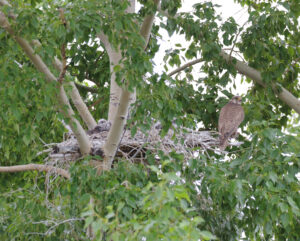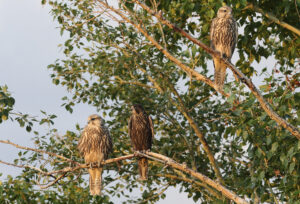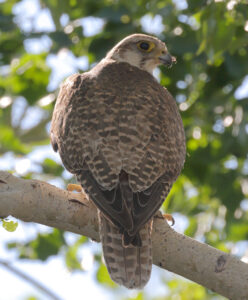Third International Scientific and Practical Conference “Eagles of the Palearctic: Study and Conservation”
Raptors Conservation. Suppl. 2. Proceedings of Conferences
Current status of the Saker Falcon in Russia and Kazakhstan
Karyakin I.V., Nikolenko E.G., Shnayder E.P. (Russian Raptor Research and Conservation Network; Sibecocenter LLC, Novosibirsk, Russia)
Contact:
Igor Karyakin ikar_research@mail.ru
Elvira Nikolenko elviranikolenko@gmail.com
Elena Shnayder equ001@gmail.com
Recommended citation: Karyakin I.V., Nikolenko E.G., Shnayder E.P. Current status of the Saker Falcon in Russia and Kazakhstan. – Raptors Conservation. 2023. S2: 450–458. DOI: 10.19074/1814-8654-2023-2-450-458 URL: http://rrrcn.ru/en/archives/35225
The range and abundance of Saker Falcon (Falco cherrug) in Russia and Kazakhstan are systematically declining. It is no exaggeration to say that the Saker Falcon is by far the most endangered raptor species in the Palaearctic.
A compilation of literature data shows the species’ estimated abundance in 1970s Russia was at least 9,000–10,000 pairs (Galushin, 2004; Karyakin, 2008), while it appears over 15,000 pairs nested in Kazakhstan – in the 1990s their abundance there was estimated at 5,218 (4,808–5,628) pairs. In 2003, total abundance in Russia (without Crimea) was estimated at 2,520 (2,115–2,925), and in 2004 there were 2,108–2,915 nesting sites (Karyakin et al., 2005). By 2010, Saker Falcon abundance in Crimea was estimated at 163–181 pairs (Milobog et al., 2010).
Between 2004 and 2018 the species completely stopped nesting in the near Volga River area region in the Southern Urals and largely disappeared in Western Siberia lowlands. By 2014, Saker Falcon abundance was estimated to be 1,869 (1,628–2,197) pairs in Russia, and by 2018 1,530–1,925 pairs, of which 1,103–1,216 pairs nested in the Altai-Sayan region (ASR), 185–230 pairs in the Baikal region, 72–264 pairs in Dauria, and 145–184 pairs in the Republic of Crimea (Karyakin et al., 2006; 2011; 2018; Karyakin, Nikolenko, 2015).
The most prosperous Russian population of Saker Falcon is in the ASR, where regular monitoring of the species occurs. Their abundance has decreased by 43% over 20 years (Karyakin et al., 2018). If at the end of the 1990s 2,056 (1,962–2,150) pairs were thought to nest in the ASR, by 2019 there were just 1,130 (1,076–1,179) pairs. However, compared to other territories, the species’ situation in the ASR can viewed favorably. On the Crimean Peninsula, the Saker Falcon’s decline in abundance is calculated to range by 4.1 to 17.7% over 5 years by 2015 (Milobog et al., 2010; Karyakin, Nikolenko, 2015).
Some small nesting groups of Saker Falcon remain in the Baikal region, where local researchers assess the situation as consistently bad. After equipping 150 km of bird-hazardous power lines with protective devices in Daursky Nature Reserve’s enforcement zone in Transbaikalia, by 2017 species abundance had tripled over the 2010 total (Goroshko, 2018), although in this case we are only talking about a few pairs. In recent years, overwintering Saker Falcons have been regularly encountered in Primorye (O. Katugin, pers. com.), and there is a chance that a breeding group remains in Manchuria on the border with China, but there is no data to support this. Considering the negative dynamics of its large population groups, current Saker Falcon abundance in Russia is estimated at 1,356–1,618 pairs (Karyakin et al., 2020).
As of 2010, abundance in Kazakhstan was estimated at 2,030 pairs (1,882–2,179), while as of 2012, no more than 1,500 pairs are estimated. Over a 20-year period, their abundance in Kazakhstan fell by over 60% (Karyakin et al., 2015). In 2011–2023, the authors and other researchers regularly visited groups of the species across Kazakhstan, conducting either systematic monitoring of known nesting sites or onetime observations. The report summarizes all available data.
In 2022–2023, within the framework of a Biodiversity Research & Conservation Center project supported by the Critical Ecosystem Partnership Fund and WWF, areas in Southern and Southeastern Kazakhstan where stable groups known to be present as recently as 2010 were carefully studied. In 2022 in the Karatau Mountains and adjacent areas Saker Falcon abundance is estimated at 46 (28–66) breeding pairs; this comprises a 77% decline from 2010 levels (Karyakin et al., 2022). In 2023, monitoring of nesting areas in the Tarbagatai Mountains, Dzhungaria, ChuIli Mountains, and the Balkhash region showed isolated incidents of Saker Falcon nesting in areas remote from highways and where the Saker Falcon’s main food resource consisted of small colonial birds (Rooks Corvus frugilegus, Jackdaws Corvus monedula, Rosy Starlings Sturnus roseus). Over the last five years, there has been a complete disappearance of rodents in the Syugaty and Boguty Mountains and the Saker Falcon did not breed (A. Kovalenko, P. Pfander, pers. com.). The authors visited south central Kazakhstan in July 2017 and July 2018; not a single sighting of the species occurred on two monthlong expeditions in the Karaganda region. On Western Kazakhstan’s Ustyurt Plateau, where one of the largest populations of the species remained until 2010 (Pfeffer, Karyakin, 2010), episodic monitoring has been carried out over the past ten years, documenting the disappearance of falcons in the majority of regularly monitored nesting areas (M. Pestov, A. Pazhenkov, I. Smelyansky, pers. com.). Beginning in 2001 in the Naurzumsky State Nature Reserve, a noticeable negative trend emerged in the abundance of a Saker Falcon breeding group: in 2001–2004 abundance ranged from 17 to 20 pairs, 15 pairs were documented in 2005, and 14 pairs in 2006–2008 (Bragin, Bragin, 2009), but no monitoring has taken place there in recent years. Saker Falcons were not studied on Kokchetavskaya Upland or in Irtysh forests in Pavlodar and Semipalatinsk Regions. However, given the reduction in the area of forest plantations as a result of fires and logging, a significant reduction in species abundance can be expected along the lines of similar declines in Altai Kray (Russian Federation), where the Saker Falcon has almost completely disappeared. It should also be noted that, despite this, illegal poachers continue to trap migrant individuals along the forests and foothills of Altai (Hunting Supervision Department data, Altai Kray, Russian Federation), and their activity in the area renders any restoration of the Saker Falcon nesting group in this territory unlikely.
Most information about negative factors reducing Saker Falcon abundance stems from an analysis of the fate of birds in the ASR tagged with GPS trackers, as well as information about the ring recoveries labeled with RRRCN.RU. Between 2002 and 2023 52 Saker Falcon nestlings received trackers. Just 4 birds survived the first calendar year of life, but died or were poached in their second year. There have been 13 ring recoveries over the same years.
Trapping to support the demands of the falconry industry is first among accurately established reasons for the departure of Saker Falcons. This activity is unsustainable in our view, given that it occurs despite steadily decreasing species abundance. We learned of the legal trapping of six birds thanks to reports by trappers working in northern Mongolia who captured bird wearing our rings and/or trackers. Thanks to these reports, we know the colossal scale of the removal of Saker Falcons from the wild. One of the birds wearing a tracker (Mityunya) was caught twice during a single season. In addition, the prioritized removal of females (by trappers) is evidenced by single males holding nesting sites for many years in the absence of available females in the population, as well in nearly annual changes of the female bird in pairs observed in the ASR. (We have calculated the average age of males and females on nesting sites, on the basis of monitoring since 1999).
The second most important factor is the death by electrocution of birds on power lines. After 2010, remaining groups of birds in Russia were found in areas where the majority of bird-hazardous power transmission lines were retrofitted with bird-protective devices or rebuilt. In the last seven years, isolated cases of death have only been documented on badly-equipped power lines, or where the protective equipment fails. In other regions where Saker Falcon deaths were recorded before 2010, no nesting groups remain today.
The third factor is insufficient food resources. A prolonged population depression of Daurian Pika (Ochotona dauurica) in the ASR on the border with Mongolia has led to the fact that, over the past four years, nesting at the monitoring site has decreased from 16 pairs to just one. That pair raised just one nestling in 2023. Since 2017 in Kazakhstan, some nesting sites have also been left empty due to a deep decline in rodent abundance. For the sake of comparison, Saker Falcon pairs can successfully raise 5–6 nestlings at a time in areas far from trappers and with a low density of nesting pairs.
Poisoning is the fourth most negative factor: (1) Anticoagulant rodenticides are responsible for a 50% decline in a large group in the Altai Mountains, where, in contrast to the effect of trapping, both males and females disappeared from nesting territories. It was not possible to collect tissue from fresh Saker Falcon corpses for chemical analysis, but poisoning was proven to be the cause of death in Black Kites (Milvus migrans) and Steppe Eagles (Aquila nipalensis) that died nearby. (2) Carbofuran in pigeons specially prepared as poisoned bait by pigeon breeders. In both the ASR in Russia and in the Caucasus, there have been over 30 cases of poisonings of large falcons, including six Saker Falcons.
The last factor we note is climate change, which regularly leads to low reproductive success in many ASR groups due to:
(1) Premature death of offspring during hurricanes and hail on open nests;
(2) Death of fledglings unable to feed themselves in the face of dense vegetation in July resulting due to precipitation. In this case, even with abundant food supply, young birds die before dispersal from nesting areas.
An entire range of measures is needed to preserve the Saker Falcon:
(1) Combating illegal trapping in falcon nesting areas, along migration routes, and in wintering areas;
(2) Strengthening enforcement related to legal falcon trapping in Mongolia and enact a ban on bird trapping in Western Mongolia, through which and where Russian birds migrate and overwinter;
(3) Implementation of bird protection measures on power lines throughout all countries of the species’ range;
(4) Identifying and ending cases of bird poisoning by pigeon breeders, including legally trying particularly serious cases, the results of which are freely illustrated by poisoners on social networks;
(5) Expanding the geographic area for creating artificial nests to attract falcons, including attracting breeding birds to artificial nest sites on power lines in partnership with energy companies;
(6) Implementing measures to improve the nestling survival rates in natural conditions: strengthening natural nests, supportive supplemental feeding of broods, tattooing the cere and tarsus during tagging to reduce the commercial attractiveness of falcons for trappers;
(7) Release of falcons raised in nurseries into the wild using the “hacking” method and mandatory tattooing of the cere and tarsus of released birds.

Saker Falcon (Falco cherrug) nest on the artificial platform mounted on the poplar tree. Photo by E. Schnayder.


